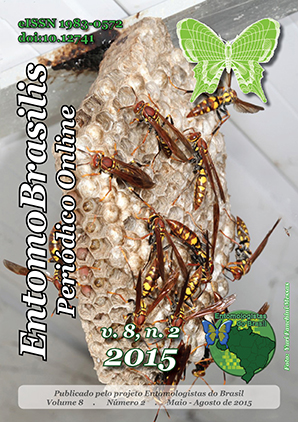Interações agressivas em abelhas sem ferrão: Melipona quadrifasciata (Lepeletier) invadindo ninho de Scaptotrigona bipunctata (Lepeletier)
DOI:
https://doi.org/10.12741/ebrasilis.v8i2.472Keywords:
Defense, Intruders, Meliponini, Nest usurpation, Social bees.Abstract
Este registro descreve a ocorrência de conflitos entre as abelhas sem ferrão de uma colônia ativa de Scaptotrigona bipunctata (Lepeletier) e os indivíduos de Melipona quadrifasciata (Lepeletier), e discute possíveis hipóteses que motivaram o ataque. Os comportamentos foram observados em uma colônia ativa de S. bipunctata. Os indivíduos de M. quadrifasciata que invadiram a colônia foram detidos pelos guardas do ninho ativo. As hipóteses de equívoco na identificação da entrada da colônia e erro na espécie possível à agregação foram descartadas, entretanto, a hipótese da real invasão registrada neste estudo demonstra uma estratégia comportamental de M. quadrifasciata e sugere que exista uma economia de energia caso tenha sucesso na pilhagem.
Agressive Interactions in Stingless bees: Melipona quadrifasciata (Lepeletier) Invading Nest of Scaptotrigona bipunctata (Lepeletier)
Abstract. This record describes the occurrence of conflicts between stingless bees of an active colony of Scaptotrigona bipunctata (Lepeletier) and individuals of Melipona quadrifasciata (Lepeletier), and discusses possible hypotheses that motivated the attack. Behaviors were observed in an active colony of S. bipunctata. The active nest guards detained individuals of M. quadrifasciata who invaded the colony. The chances of misidentification of the colony entrance and error in the species possible aggregation were discarded, however, the hypothesis of the real invasion recorded in this study demonstrates a behavioral strategy by M. quadrifasciata suggests that there is an energy savings if successful in looting.
References
Altmann, J., 1974. Observation study of behavior: sampling methods. Behaviour, 49: 223-265.
Castro, L.C., P.N. Silva & F. Prezoto, 2009. Unusual nesting behavior in a neotropical stingless bee, Nannotrigona testaceicornis (Hymenoptera: Apidae). Sociobiology, 53: 569-572,
Cortopassi-Laurino, M., 2004. A Uru
Gil, M., R.J. De Marco & R. Menzel, 2007. Learning reward expectations in Honeybees. Learning & Memory, 14: 491-496.
Kerr, W.E., G.A. Carvalho & V.A. Nascimento, 1996. Abelha uru
Michener, C.D., 1974. The Social Behavior of the Bees: a comparative study. Massachusetts, Harvard University Press, 404 p.
Michener, C.D., 2007. The bees of the World. Baltimore, D.C, John Hopkins, 953 p.
Nogueira-Neto, P., 1970. A Cria
Nogueira-Neto, P., 1997. Vida e cria
Oliveira, F.F., B.T.T. Richers, J.R. Silva, R.C. Farias & T.A.L. Matos, 2013. Guia Ilustrado das Abelhas
Pirani, J.R. & M. Cortopassi-Laurino, 1993. Flores e Abelhas em S
Roubik, D.W., 1989. Ecology and Natural History of Tropical Bees. Cambridge University Press, New York, 514 p.
Roubik, D.W., 2006. Stingless bee nesting biology. Apidologie, 37: 124-143.
Silveira, F.A., G.A.R. Melo & E.A.B. Almeida, 2002. Abelhas brasileiras: sistem
Stuart, R.J., 1988. Collective cues as a basis for nestmate recognition in polygynous leptothoracine ants. Proceedings of the National Academy of Sciences, 85: 4572-4575.
Van Zweden, J.S. & P. D
Wilson, E.O., 1971. The Insect Societies. Cambridge, Massachusetts: Belknap Press, 548 p.
Downloads
Published
How to Cite
Issue
Section
License
Access is unrestricted and the documentation available on the Creative Commons License (BY) (http://creativecommons.org/licenses/by/4.0/ ).
I declare for proper purposes that the copyright of the submitted text is now licensed in the form of the Creative Commons License, as specified above.
The copyright of the article belongs to the authors
















